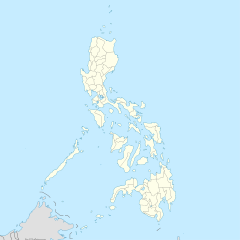Angono Petroglyphs
| Mga Petroglipo ng Angono | |

Petroglyphs on a rock wall, Rizal, Philippines
|
|
| Alternate name | Petroglyphs of the Rock-shelter Angono-Binangonan Petroglyphs |
|---|---|
| Location | Angono, Binangonan and Antipolo, Rizal, Philippines |
| Coordinates | Lua error in package.lua at line 80: module 'strict' not found. |
| Type | Cave |
| History | |
| Periods | Neolithic Period |
| Management | National Museum of the Philippines |
The Angono Petroglyphs (Filipino: Mga Petroglipo ng Angono) is the oldest known work of art in the Philippines located in the province of Rizal. There are 127 human and animal figures engraved on the rockwall probably carved during the late Neolithic.[1] These inscriptions clearly show stylized human figures, frogs and lizards, along with other designs that may have depicted other interesting figures but erosion may have caused it to become indistinguishable. The engravings are mostly symbolic representations and are associated with healing and sympathetic magic.[2]
The site has been declared by the National Museum of the Philippines as a National Cultural Treasure in 1973. It is also included in the list of the World Inventory of Rock Art in 1985 and historic sites of the World Monuments Watch and World Monuments Funds[3] and part of the Philippines' tentative list of the UNESCO World Heritage Site.
History
Lua error in package.lua at line 80: module 'strict' not found. The existence of a rock shelter was reported to the National Museum by the late National Artist of the Philippines Carlos V. Francisco in March 1965 during a field trip with several boy scouts along the boundaries of Angono, Binangonan and Antipolo of the province of Rizal.[3][4][5] Since then, some rock carvings have been damaged due to neglect and vandalism. In 1973, by virtue of Presidential Decree No. 260, it was declared as a national cultural treasure by the Philippine government.[6] During that time, a team led by the National Museum of the Philippines started archaeological site conservation and site development of the petroglyphs in which a mini-museum, view deck and stone path, among others, were constructed. It was included in the list of National Cultural Treasures in 1973 and World Inventory of Rock Art in 1985. In 1996, The World Monuments Fund included Angono Petroglyphs on its list of preservation projects and has helped with the installation of a drainage system and assigned a caretaker to protect the site.[7] The site is also on the tentative list of UNESCO World Heritage Sites of the Philippines.[8]
Description
The Angono Petroglyphs of Binangonan is located in a shallow rock shelter. It measures 63 meters wide, 8 meters deep and a maximum height of 5 meters. It has been created due to faulting and formed in volcanic soil during the Quaternary period. There are 127 drawings in the form of animate and static figures of circular or dome-like head on top of a 'V' shaped torso distributed on a horizontal plane on the rock wall area measuring 25 meters by 3 meters. Only 51 of the total 127 drawings are distinct. Due to the complexity and plurality of the drawings, it is suggested that the drawings on the rock were not only created by a single individual.[3]
Archaeological Excavations
From October to November 1965, archaeological excavations, headed by Alfredo Evangelista, was done on the area of the rock shelter.[5] Fragmented bits of earthenware, two pieces of obsidian flakes, two chert, flake stone tools, one stone core tool and polished stone adze with a blunted working edge were excavated in the rock shelter. The artifacts suggest that the site was used during the Neolithic age.[3]
Management
The preservation and development of the Angono Petroglyphs is a collective effort of the National Museum of the Philippines, the Department of Tourism, World Monuments Fund, American Express and a Philippine real estate company.[9]
The site of the Angono Petroglyphs is developed as the Angono Branch of the National Museum in 1998 showcasing the cultural and artistic heritage of the province of Rizal.[5] Its collections include remains of giant turtle, tusks, fossils, molar of Elephas sp., tradeware ceramics and paintings.
References
- ↑ Lua error in package.lua at line 80: module 'strict' not found.
- ↑ Lua error in package.lua at line 80: module 'strict' not found.
- ↑ 3.0 3.1 3.2 3.3 Lua error in package.lua at line 80: module 'strict' not found.
- ↑ Lua error in package.lua at line 80: module 'strict' not found.
- ↑ 5.0 5.1 5.2 Lua error in package.lua at line 80: module 'strict' not found.
- ↑ Lua error in package.lua at line 80: module 'strict' not found.
- ↑ Lua error in package.lua at line 80: module 'strict' not found.
- ↑ Lua error in package.lua at line 80: module 'strict' not found.
- ↑ Lua error in package.lua at line 80: module 'strict' not found.
